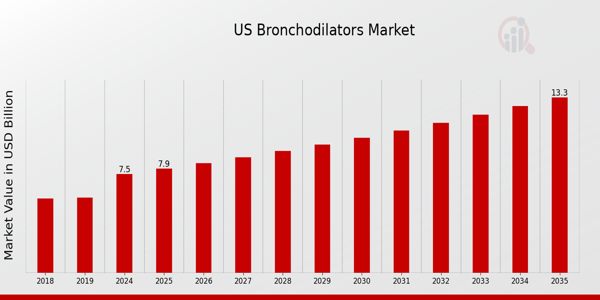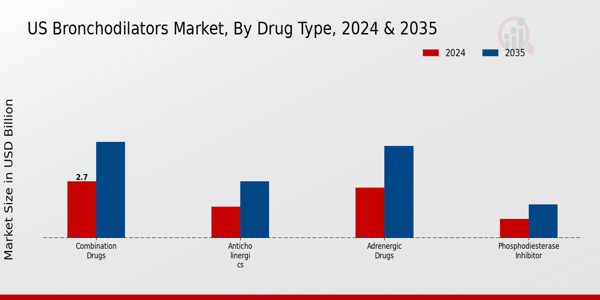US Bronchodilators Market Overview
Market Size and Growth
As per MRFR analysis, the US Bronchodilators Market Size was estimated at 7.1 (USD Billion) in 2023. The US Bronchodilators Market Industry is expected to grow from 7.5 (USD Billion) in 2024 to 13.3 (USD Billion) by 2035. The US Bronchodilators Market CAGR (growth rate) is expected to be around 5.346% during the forecast period (2025 - 2035).
Key US Bronchodilators Market Trends Highlighted
The US Bronchodilators Market is experiencing significant trends that reflect the evolving landscape of respiratory healthcare. A key market driver is the increasing prevalence of chronic respiratory diseases, such as asthma and chronic obstructive pulmonary disease (COPD). The growing awareness regarding these conditions among healthcare professionals and patients has led to heightened demand for effective bronchodilator treatments. Additionally, advancements in drug delivery systems, such as nebulizers and inhalers, have contributed to improved patient compliance and treatment outcomes. Opportunities to be explored lie in the development of novel bronchodilator therapies and combination drugs that enhance efficacy while minimizing side effects.
The rise of personalized medicine is also creating pathways for tailored treatment approaches based on individual patient profiles, potentially improving the management of respiratory conditions. Furthermore, the increasing focus on home healthcare solutions presents a unique opportunity for the bronchodilator market. As patients prefer receiving care in the comfort of their homes, manufacturers are likely to explore portable and user-friendly devices. In recent times, there has been a shift towards biologics and targeted therapies in managing severe asthma cases in the US.
This trend is supported by a growing body of research that highlights the potential of biologic drugs to provide more effective long-term relief.
Additionally, the COVID-19 pandemic has brought attention to the importance of respiratory health, leading to increased investments in respiratory medicine and innovation. Collaborations between pharmaceutical companies and technology firms are emerging, aimed at integrating digital health solutions with bronchodilator therapies, thus enhancing patient monitoring and adherence. Overall, the US Bronchodilators Market continues to evolve, driven by patient needs and technological advancements.

Source: Primary Research, Secondary Research, Market Research Future Database and Analyst Review
US Bronchodilators Market Drivers
Increasing Prevalence of Respiratory Diseases
The rise in respiratory diseases such as asthma and chronic obstructive pulmonary disease (COPD) is a significant driver for the US Bronchodilators Market Industry. According to the Centers for Disease Control and Prevention (CDC), approximately 25 million Americans have asthma, equating to roughly 8% of the population, with a significant number of these individuals requiring bronchodilator treatments. The growing awareness and early diagnosis of respiratory ailments are expected to further raise the demand for bronchodilators.
Additionally, the National Heart, Lung, and Blood Institute reports that COPD affects over 16 million Americans, leading to increasing healthcare expenditures and prompting health authorities to advocate for more effective therapies. This trend demonstrates a clear and sustained demand for bronchodilator medications, reinforcing market growth potential.
Advancements in Drug Formulations and Technology
The ongoing Research and Development (R&D) efforts aimed at producing advanced bronchodilator formulations and inhalation devices are propelling the US Bronchodilators Market Industry. Manufacturers like Pfizer and AstraZeneca are heavily investing in innovative drug delivery systems that maximize the efficacy and safety of bronchodilators. Recent developments include combination therapies that enhance treatment outcomes while minimizing side effects. According to a report by the FDA, over 200 new drugs are approved each year, with a large segment focused on respiratory therapies.
These technological advancements not only improve patient compliance but also widen the market scope, indicating a robust growth trajectory for the bronchodilator sector in the US.
Increase in Aging Population
In the United States, the demographic shift towards an aging population is anticipated to be a significant market driver for the US Bronchodilators Market Industry. By 2030, all baby boomers will be over the age of 65, leading to an expected proportion of around 20% of the total US population. Older adults are more susceptible to developing respiratory diseases, which correlates with a higher demand for bronchodilator therapies. The Administration on Aging reports that individuals aged 65 and older typically face a higher rate of hospitalizations due to respiratory conditions, thus contributing to an increased utilization of bronchodilators.
This demographic trend underscores the ongoing need for effective bronchodilator treatments in the coming years, fostering an environment for market growth.
Government Initiatives and Policymaking
Government initiatives aimed at enhancing healthcare accessibility and affordability play a vital role in shaping the US Bronchodilators Market Industry. The U.S. government has established various healthcare policies advocating for the management of chronic respiratory diseases. Programs such as the Affordable Care Act have increased insurance coverage for respiratory treatments, thereby expanding access to bronchodilator medications. Furthermore, the National Asthma Control Program encourages preventive measures and better management of asthma, leading to a higher demand for bronchodilators.
The support from the government not only improves treatment outcomes but also stabilizes the market trends, highlighting the impact of policy changes on the bronchodilator sector.
US Bronchodilators Market Segment Insights
Bronchodilators Market Drug Type Insights
In the US Bronchodilators Market, the Drug Type segment plays a critical role in catering to patients with respiratory conditions such as asthma and chronic obstructive pulmonary disease (COPD). Adrenergic drugs are particularly significant due to their ability to effectively relax the bronchial muscles by stimulating beta-adrenergic receptors, leading to rapid relief during acute asthma attacks. In addition, Anticholinergics offer a unique approach by blocking the action of acetylcholine, which is known to constrict airways; this makes them essential for patients who require long-term management of COPD.
Furthermore, Phosphodiesterase Inhibitors have gained attention for their ability to enhance bronchodilation through the inhibition of phosphodiesterase enzymes, thereby increasing intracellular cAMP levels, and offering an alternative treatment pathway for patients who may not respond well to traditional bronchodilators. Combination Drugs, which integrate adrenergic and anticholinergic properties, provide a synergistic effect, allowing for comprehensive management of respiratory symptoms while enhancing patient compliance by reducing the number of medications required.
These insights into various drug types highlight the crucial role they play in the US Bronchodilators Market, with each sub-segment addressing specific therapeutic needs and ensuring better management of respiratory diseases. The development and innovation within these drug types are driven by the increasing prevalence of respiratory ailments in the US, with a growing emphasis on patient-centered approaches and personalized treatment plans. As the healthcare landscape continues to evolve, opportunities arise for new formulations and delivery methods, propelling market growth and improving patient outcomes.

Source: Primary Research, Secondary Research, Market Research Future Database and Analyst Review
Bronchodilators Market Disease Insights
The US Bronchodilators Market operates within a structure that segments diseases primarily into Asthma, Chronic Obstructive Pulmonary Disease (COPD), and Other respiratory conditions. Asthma represents a significant portion of the market due to its high prevalence among various age groups, contributing to increased healthcare spending and frequent hospital admissions. COPD is another critical aspect, often arising from smoking and environmental factors, leading to substantial mortality and morbidity, thus emphasizing the need for effective bronchodilator therapies. The Other category incorporates a range of less common respiratory disorders that still require bronchodilation treatment, highlighting the diversity of needs within the market.
The market's growth is driven by rising pollution levels and an aging population, which exacerbate respiratory illnesses. Moreover, advancements in Research and Development introduce innovative therapies to improve patient outcomes, while challenges such as medication adherence and the complexity of treatment regimens persist. Overall, the US Bronchodilators Market segmentation by disease showcases the vital role of targeted treatment strategies in managing respiratory diseases effectively.
Bronchodilators Market Mode of Action Insights
The US Bronchodilators Market is a vital segment within the broader respiratory therapeutics industry, categorized primarily by the Mode of Action. This includes Short-Acting Bronchodilators and Long-Acting Bronchodilators, both of which serve essential roles in the management of chronic respiratory conditions such as asthma and chronic obstructive pulmonary disease (COPD). Short-Acting Bronchodilators are often the first line of treatment for acute symptoms due to their rapid onset, making them critical for patients experiencing sudden breathing difficulties.
In contrast, Long-Acting Bronchodilators are significant for their sustained effect, contributing to better overall disease control and improving patients' quality of life with less frequent dosing requirements.
The importance of the Long-Acting category lies in its ability to provide improved patient adherence to therapy, addressing the compliance challenges often faced in chronic diseases. The growing prevalence of respiratory conditions in the US, driven by factors such as aging populations and environmental pollutants, is propelling demand in this market. Moreover, continuous advances in formulations and delivery mechanisms are creating opportunities for enhanced efficacy and safety, further solidifying the role of both Short-Acting and Long-Acting Bronchodilators in therapeutic regimens.
With the ongoing Research and Development efforts, both segments are poised to evolve, highlighting their significance in the overall landscape of the US Bronchodilators Market.
Bronchodilators Market Route of Administration Insights
The Route of Administration segment within the US Bronchodilators Market plays a crucial role in the overall therapy for respiratory conditions such as asthma and chronic obstructive pulmonary disease. The primary methods of administration include Oral and Parenteral routes, each offering unique advantages that cater to different patient needs. Oral administration is often favored for its ease of use and patient compliance, making it a significant choice among healthcare providers.
On the other hand, Parenteral administration, which can deliver medications directly into the bloodstream, is critical for patients who may not respond well to oral medications or require rapid therapeutic effects. The increasing prevalence of respiratory diseases in the US highlights the demand for diverse administration routes, driving the market's growth. Furthermore, advancements in formulations and delivery technologies are likely to enhance the effectiveness and safety profiles of these routes. As a result, the Route of Administration segment continues to evolve, providing numerous opportunities for innovation and improved patient outcomes in the US Bronchodilators Market.
The market is shaped significantly by these trends, contributing to the dynamics of the overall US Bronchodilators Market revenue and its ongoing expansion.
US Bronchodilators Market Key Players and Competitive Insights
The US Bronchodilators Market is characterized by a dynamic landscape driven by a combination of established pharmaceutical companies and emerging players striving to innovate and expand their product offerings. This market primarily caters to individuals suffering from chronic respiratory conditions like asthma and chronic obstructive pulmonary disease (COPD), leading to a consistent demand for bronchodilator therapies. Competitive insights in this sector highlight an ongoing trend of collaboration and mergers, with companies focusing on enhancing their research and development capabilities to bring forth more effective treatments.
The regulations governing drug approval and market entry also play a crucial role in shaping competitive strategies, compelling companies to invest in compliance and patient education to differentiate their products.
Teva Pharmaceutical Industries has carved out a prominent presence in the US Bronchodilators Market through its broad portfolio of generic medications and innovative therapies. The company's strengths lie in its extensive experience and expertise in respiratory therapeutics, providing accessible options that cater to diverse patient needs. Teva emphasizes affordability and availability, which resonate well with healthcare providers and patients within the competitive landscape. This company's commitment to expanding its research capabilities and enhancing existing formulations allows it to maintain relevance in a rapidly evolving market.
As Teva continues to focus on improving patient outcomes and advancing its product pipeline, its position in the US market remains robust owing to its strategic initiatives and responses to market demands.
AstraZeneca has established itself as a key player in the US Bronchodilators Market, largely credited to its innovative product offerings and strong brand recognition. The company is known for its flagship bronchodilator medications that have received widespread acceptance among healthcare professionals. AstraZeneca's strengths within this market stem not only from its advanced research and development framework but also from strategic partnerships and mergers aimed at bolstering its market position. The company actively engages in clinical trials aimed at understanding the long-term efficacy of its bronchodilator products, which fosters continued innovation and regulatory compliance.
Through its dedication to patient care and a growing portfolio of respiratory therapeutics, AstraZeneca remains competitive and influential in shaping the US Bronchodilators Market by meeting the needs of patients while navigating regulatory challenges.
Key Companies in the US Bronchodilators Market Include
- Teva Pharmaceutical Industries
US Bronchodilators Market Industry Developments
Recent developments in the US Bronchodilators Market have seen significant activity, particularly among key players such as Teva Pharmaceutical Industries, AstraZeneca, Novartis, and GlaxoSmithKline. The growing demand for effective treatment of respiratory diseases has driven innovation, with increased research and development investments aimed at improving existing therapies. Bristol-Myers Squibb announced in September 2023 enhancements to its inhaler technologies, emphasizing patient adherence and ease of use.
Notably, AstraZeneca and Pfizer are collaborating on a new dual-action bronchodilator expected to enter clinical trials in early 2024, projecting promising outcomes for asthma management. In terms of mergers and acquisitions, in October 2022, Takeda Pharmaceutical announced the acquisition of a specialty portfolio from Mylan, which reportedly included bronchodilator therapies. This acquisition is anticipated to enhance Takeda's respiratory lineup and expand its market reach. Over the past few years, the US Bronchodilators Market has experienced growth driven by the rising prevalence of chronic obstructive pulmonary disease, exacerbated by factors such as air pollution and smoking.
Significant annual growth rates were reported, indicating a robust market outlook going forward.
US Bronchodilators Market Segmentation Insights
Bronchodilators Market Drug Type Outlook
- Phosphodiesterase Inhibitor
Bronchodilators Market Disease Outlook
Bronchodilators Market Mode of Action Outlook
- Short-Acting Bronchodilators
- Long-Acting Bronchodilators
Bronchodilators Market Route of Administration Outlook
| Report Attribute/Metric Source: |
Details |
| MARKET SIZE 2018 |
7.1(USD Billion) |
| MARKET SIZE 2024 |
7.5(USD Billion) |
| MARKET SIZE 2035 |
13.3(USD Billion) |
| COMPOUND ANNUAL GROWTH RATE (CAGR) |
5.346% (2025 - 2035) |
| REPORT COVERAGE |
Revenue Forecast, Competitive Landscape, Growth Factors, and Trends |
| BASE YEAR |
2024 |
| MARKET FORECAST PERIOD |
2025 - 2035 |
| HISTORICAL DATA |
2019 - 2024 |
| MARKET FORECAST UNITS |
USD Billion |
| KEY COMPANIES PROFILED |
Teva Pharmaceutical Industries, AstraZeneca, Novartis, GlaxoSmithKline, Eli Lilly, BristolMyers Squibb, Takeda Pharmaceutical, Forty Seven, Boehringer Ingelheim, Pfizer, Amgen, Roche, Sanofi, Mylan |
| SEGMENTS COVERED |
Drug Type, Disease, Mode of Action, Route of Administration |
| KEY MARKET OPPORTUNITIES |
Increase in asthma prevalence, Rise in COPD cases, Growth of personalized medicine, Advancements in drug delivery, Expanding telehealth services |
| KEY MARKET DYNAMICS |
Rising asthma prevalence, Increasing COPD cases, Technological advancements, Growth in inhaler devices, Expanding healthcare access |
| COUNTRIES COVERED |
US |
Frequently Asked Questions (FAQ):
The US Bronchodilators Market is expected to be valued at 7.5 billion USD in 2024.
By 2035, the market is anticipated to reach a valuation of 13.3 billion USD.
The expected CAGR for the US Bronchodilators Market from 2025 to 2035 is 5.346 %.
Adrenergic drugs are projected to dominate the market with a value of 2.4 billion USD in 2024.
The Anticholinergics segment is expected to reach a market valuation of 2.7 billion USD by 2035.
Key players include Teva Pharmaceutical Industries, AstraZeneca, Novartis, GlaxoSmithKline, and Pfizer.
The Combination Drugs segment is expected to be valued at 4.6 billion USD by 2035.
The Phosphodiesterase Inhibitor segment is projected to be valued at 0.9 billion USD in 2024.
There are significant growth opportunities driven by increasing respiratory diseases and advancing treatment technologies.
The market is expected to experience steady growth across various regions in the US during 2025 to 2035.















